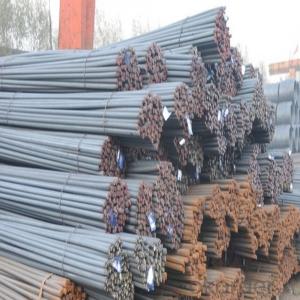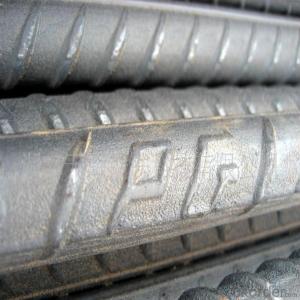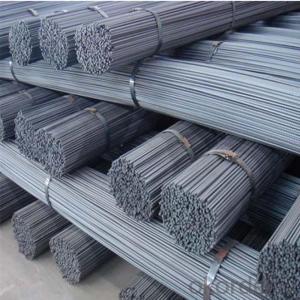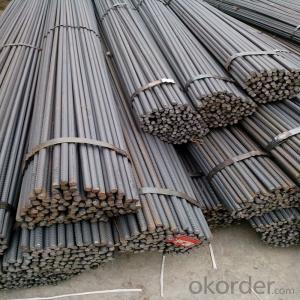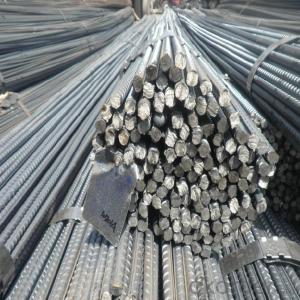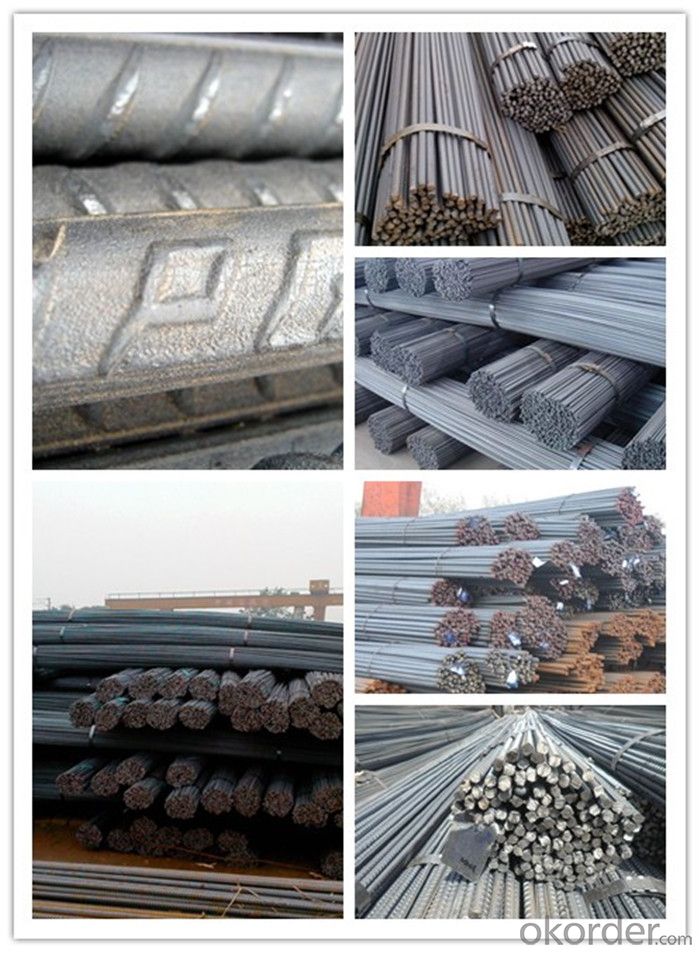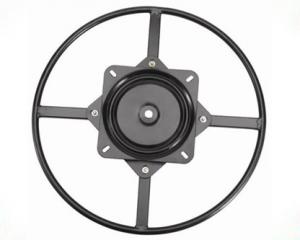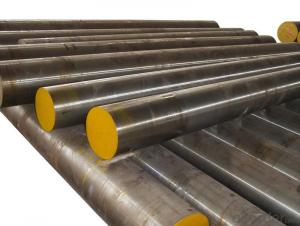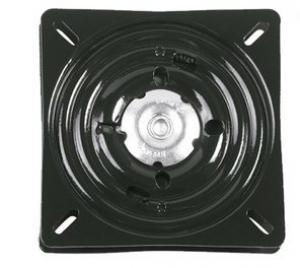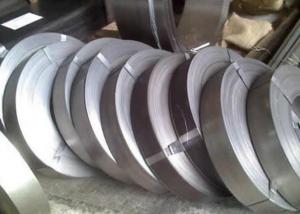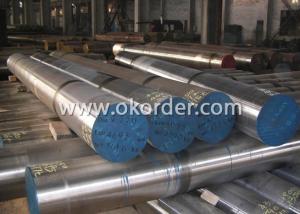Steel Rebar Size for Construction
- Loading Port:
- Tianjin
- Payment Terms:
- TT OR LC
- Min Order Qty:
- 100 m.t.
- Supply Capability:
- 50000 m.t./month
OKorder Service Pledge
OKorder Financial Service
You Might Also Like
Item specifice
Steel Rebar Size for Construction
Description of Steel Rebar Size:
1, Diameter: 5.5mm-10mm rounds reinforcing steel bar
10m- 40 rods reinforcing Steel Rebar Size
2, Length: 6m, 9m, 12m or customized
3, Standard: GB, ASTM, AISI, SAE, DIN, JIS, EN
OEM technology - send detailed technical parameters for accurate quotation.
2, Produce Process: smelt iron - EAF smelt billet - ESR smelt billet -
hot rolled or forged to get the steel round bar and plate
3, Heat Treatment: annealing, normalizing, tempering, quenching
4, Surface Treatment: Black
5, Quality Assurance: We accept third party inspection for all orders.
You can ask testing organizations such as SGS, BV, etc. to test our products before shipping.
Chemical Composition of Steel Rebar Size:
Grade | Technical data of the original chemical composition(%) | |||||
Reinforcing steel bar HRB335 | C | Mn | Si | S | P | B |
≤0.25 | ≤1.60 | ≤0.80 | ≤0.045 | ≤0.045 | >0.0008 | |
Physics Capability | ||||||
Yield Strength(N/cm2) | Tensile Strength(N/cm2) | Elongation(%) | ||||
≥ 335 | ≥490 | ≥16 | ||||
Reinforcing steel bar HRB400 | C | Mn | Si | S | P | B |
≤0.25 | ≤0.16 | ≤0.80 | ≤0.045 | ≤0.045 | 0.04-0.12 | |
Physics Capability | ||||||
Yield Strength(N/cm2) | Tensile Strength(N/cm2) | Elongation(%) | ||||
≥ 400 | ≥ 570 | ≥ 14 | ||||
Product Show of Steel Rebar Size:
Workshop
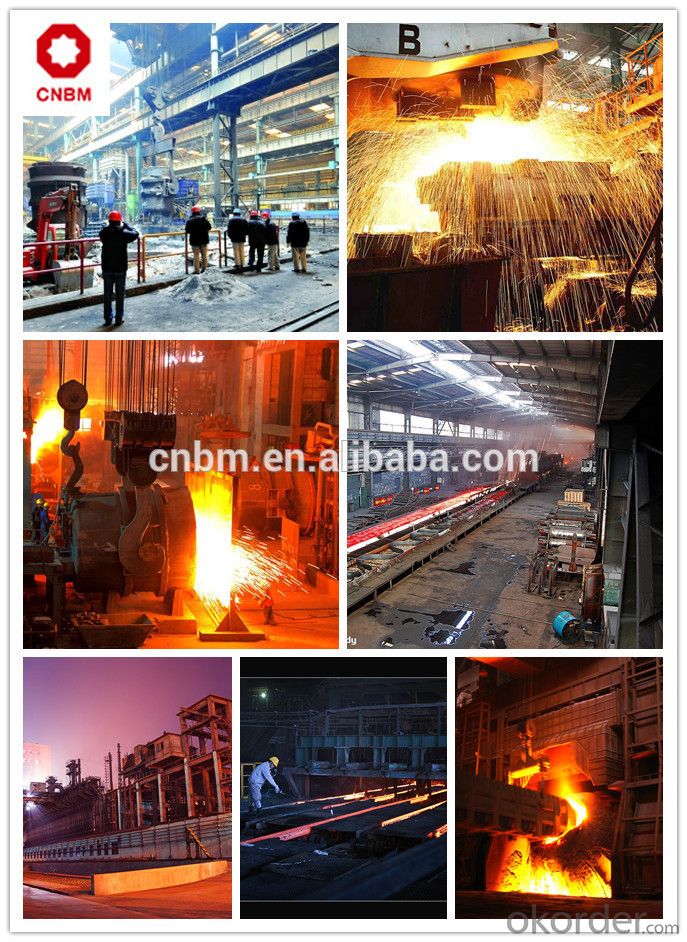
Company Information:
CNBM International Corporation is the most important trading platform of CNBM group.
Whith its advantages, CNBM International are mainly concentrate on Cement, Glass, Iron and Steel, Ceramics industries and devotes herself for supplying high qulity series of refractories as well as technical consultancies and logistics solutions.

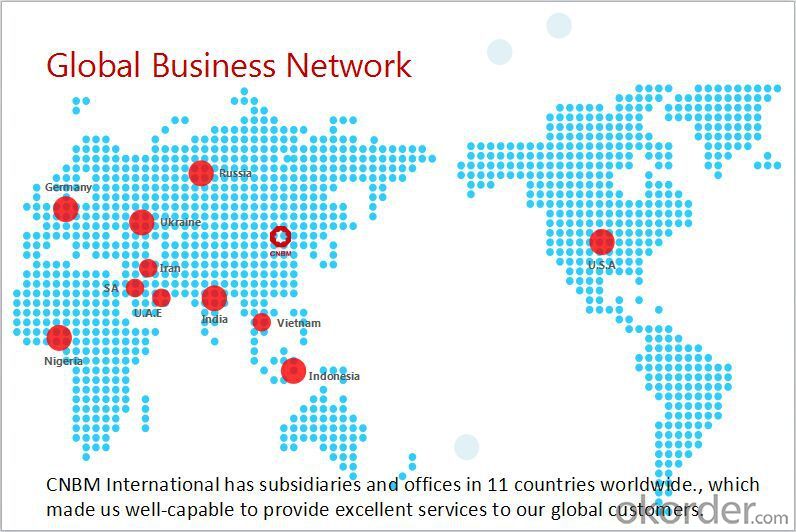
FAQ:
1, Your advantages?
professional products inquiry, products knowledge train (for agents), smooth goods delivery, excellent customer solution proposale
2, Test & Certificate?
SGS test is available, customer inspection before shipping is welcome, third party inspection is no problem
3, Factory or Trading Company?
CNBM is a trading company but we have so many protocol factories and CNBM works as a trading department of these factories. Also CNBM is the holding company of many factories.
4, Payment Terms?
30% TT as deposit and 70% before delivery.
Irrevocable L/C at sight.
5, Trading Terms?
EXW, FOB, CIF, FFR, CNF
6, After-sale Service?
CNBM provides the services and support you need for every step of our cooperation. We're the business partner you can trust.
For any problem, please kindly contact us at any your convenient time.
We'll reply you in our first priority within 24 hours.
Contact Us:

- Q:How does bearing steel contribute to the manufacturing of bearings?
- Bearing steel is a specific type of steel that offers high hardness, durability, and corrosion resistance, making it ideal for the manufacturing of bearings. The properties of bearing steel allow for the creation of strong and long-lasting bearing components that can withstand heavy loads, high temperatures, and intense rotational speeds. The steel's hardness helps to prevent wear and deformation, ensuring smooth and efficient bearing operation. Overall, bearing steel plays a crucial role in ensuring the reliability and performance of bearings in various industrial applications.
- Q:What are the different methods of controlling the grain size in special steel?
- There are several methods to control the grain size in special steel, aiming to achieve the desired mechanical properties and performance. Some of these methods include: 1. Alloying: By carefully selecting and controlling the composition of alloying elements in the steel, the grain size can be controlled. For example, elements such as niobium, vanadium, and titanium can effectively refine the grain size. 2. Heat treatment: The heat treatment process plays a crucial role in controlling the grain size. Techniques like annealing, normalizing, and quenching can be employed to manipulate the grain size. For instance, slow cooling during annealing promotes the growth of larger grains, while rapid cooling during quenching can lead to smaller grain sizes. 3. Deformation processing: Applying mechanical deformation, such as rolling, forging, or extrusion, can help refine the grain structure. These processes induce strain and promote the formation of smaller and more uniform grains. 4. Grain growth inhibitors: Adding certain elements to the steel, such as aluminum or zirconium, can act as grain growth inhibitors. These elements form fine particles that impede grain growth during heat treatment, resulting in a smaller grain size. 5. Transformation temperature control: By controlling the transformation temperature during heat treatment, the grain size can be manipulated. For example, lowering the austenitizing temperature can produce a finer grain structure in the final product. 6. Rapid solidification: Utilizing techniques like spray forming or rapid quenching can result in an ultrafine-grained microstructure. The rapid cooling prevents grain growth, leading to a fine and homogeneous grain structure. 7. Severe plastic deformation (SPD) techniques: SPD techniques, such as equal channel angular pressing (ECAP) or high-pressure torsion (HPT), can impose significant strain on the material, leading to a refined grain structure. These techniques are typically used for producing ultrafine-grained or nanostructured steels. It is important to note that the choice of the method for controlling grain size in special steel depends on the desired properties, the alloy composition, and the intended application of the final product.
- Q:What are the advancements and trends in the field of special steel?
- Recent years have seen remarkable progress and emerging patterns in the field of special steel, which have brought about revolutionary changes in various industries. The primary driving force behind these advancements is the increasing demand for high-performance materials in critical applications such as aerospace, automotive, energy, and construction. One of the major breakthroughs in the field of special steel is the development of advanced manufacturing techniques. Conventional steel production methods have been replaced by more efficient processes, such as electric arc furnaces and vacuum induction melting, resulting in improved steel quality and enhanced mechanical properties. These advancements have made it possible to produce special steels with exceptional strength, corrosion resistance, and heat resistance. Another significant trend in the field of special steel is the emergence of new alloy compositions. Researchers and manufacturers are continuously exploring and developing innovative alloying elements to enhance the properties of special steels. For example, the addition of elements like chromium, molybdenum, and vanadium has led to the creation of stainless steels with outstanding resistance to corrosion and oxidation. Furthermore, advancements in heat treatment processes have also been witnessed in the field of special steel. By utilizing advanced heat treatment techniques such as quenching and tempering, austempering, and martempering, special steels can achieve the desired hardness, toughness, and dimensional stability. These advancements have significantly broadened the range of applications for special steels, allowing them to be used in critical components that operate under extreme conditions. In addition to the progress in manufacturing and alloy compositions, there is a growing inclination towards the development of environmentally friendly special steels. With increasing concerns about sustainability and carbon footprint, researchers and manufacturers are focusing on reducing the environmental impact of steel production. This has resulted in the creation of special steels with lower carbon content, as well as the implementation of energy-efficient manufacturing processes. Moreover, the field of special steel is witnessing the integration of digital technologies and automation. The utilization of artificial intelligence, machine learning, and data analytics enables manufacturers to optimize production processes, improve quality control, and reduce costs. This shift towards Industry 4.0 is transforming the production and utilization of special steel, ensuring greater efficiency and precision in the manufacturing process. In conclusion, the field of special steel is experiencing significant advancements and trends that are fostering innovation in various industries. The development of advanced manufacturing techniques, new alloy compositions, improved heat treatment processes, environmentally friendly production methods, and the integration of digital technologies are revolutionizing the properties and applications of special steel. These advancements have not only enhanced the performance and durability of special steel but have also opened up new possibilities for its utilization in critical applications.
- Q:How does special steel behave under different types of loading conditions?
- Special steel, also known as alloy steel, exhibits unique behavior under different types of loading conditions. It is specifically designed to possess exceptional mechanical properties, making it suitable for a wide range of applications where high strength, toughness, and resistance to wear or corrosion are required. Under tension loading, special steel demonstrates excellent tensile strength and ductility, enabling it to withstand pulling forces without easily fracturing. This property makes it ideal for applications where components are subjected to pulling or stretching forces, such as cables, structural elements, or automotive parts. When subjected to compressive loading, special steel showcases its exceptional compressive strength, allowing it to withstand forces that tend to squeeze or press it together. This makes it suitable for applications like hydraulic cylinders, crankshafts, or flanges, where resistance to compression is crucial. In terms of bending or flexural loading, special steel exhibits remarkable flexibility without losing its strength, enabling it to withstand repeated bending without deformation or failure. This property is particularly useful in applications involving springs, suspension systems, or beams subjected to dynamic loads. Special steel also demonstrates excellent fatigue resistance, which means it can withstand cyclic loading or repeated stress without failure. This property is crucial in applications subjected to continuous or repetitive loading, such as turbine blades, gears, or axles. Moreover, special steel can effectively handle impact loading, as it possesses high toughness and impact resistance. This makes it suitable for applications where sudden shocks or impacts are expected, such as hammer heads, drill bits, or armor plating. In terms of temperature loading, special steel retains its mechanical properties even at high temperatures due to its excellent heat resistance. This property makes it suitable for applications exposed to extreme heat or thermal cycling, such as turbine components, exhaust systems, or molds used in metal casting. In summary, special steel behaves differently under various loading conditions, adapting its mechanical properties to meet the specific requirements of each application. Its unique combination of strength, toughness, ductility, and resistance to wear or corrosion make it a versatile material capable of withstanding different types of loading conditions.
- Q:How does special steel contribute to the oil and gas aftermarket industry?
- Due to its unique properties and capabilities, special steel plays a vital role in the oil and gas aftermarket industry. Its resistance to corrosion makes it well-suited for use in the harsh and corrosive environments commonly found in this sector. By preventing corrosion, special steel extends the lifespan of equipment and components, reducing the need for frequent replacements and maintenance. Additionally, special steel offers high strength and durability, enabling it to withstand the extreme pressures and temperatures encountered in oil and gas operations. This strength ensures that equipment and components made from special steel can function reliably and efficiently, even under demanding conditions. Moreover, special steel can be customized to meet the specific requirements of the oil and gas industry. With its various grades and compositions, special steel can possess specific properties, such as resistance to sulfide stress cracking, hydrogen embrittlement, and high-temperature oxidation. These tailored properties make special steel suitable for critical applications, including wellheads, pipelines, valves, and other equipment used in the oil and gas aftermarket industry. Furthermore, special steel allows for the production of complex and intricate components that are essential for the oil and gas sector. Its excellent machinability and weldability enable the creation of precision-engineered parts, ensuring the efficient and reliable operation of oil and gas equipment. In conclusion, special steel plays a significant role in the oil and gas aftermarket industry by providing corrosion resistance, high strength, durability, customization options, and the ability to manufacture intricate components. These properties make special steel indispensable in ensuring the safety, reliability, and efficiency of operations in the oil and gas sector.
- Q:What are the specific requirements for special steel used in the automotive piston industry?
- The specific requirements for special steel used in the automotive piston industry are designed to ensure high performance, durability, and efficiency of the pistons. These requirements include: 1. High strength: Special steel used in automotive pistons must possess high tensile strength and hardness to withstand the extreme pressures and temperatures generated during combustion. 2. Heat resistance: The steel must have excellent heat resistance properties to withstand the intense heat generated by the combustion process without deforming or losing strength. 3. Wear resistance: Pistons undergo constant friction and wear against the cylinder walls. Therefore, the special steel used must have good wear resistance to minimize the wear and tear and prolong the lifespan of the piston. 4. Low thermal expansion: The steel should have a low coefficient of thermal expansion to prevent excessive expansion and contraction during temperature variations, ensuring a tight seal between the piston and cylinder walls. 5. Corrosion resistance: Pistons are exposed to various corrosive elements, including combustion by-products and engine oil. Special steel used in piston manufacturing must have good corrosion resistance to prevent premature deterioration and failure. 6. Fatigue resistance: The steel should possess excellent fatigue resistance to withstand the repetitive stress cycles experienced by the piston during engine operation. 7. Machinability: Special steel used in pistons should be easily machinable to achieve precise dimensions and tolerances necessary for optimal performance. 8. Cost-effectiveness: While meeting the above requirements, special steel used in the automotive piston industry should also be cost-effective to ensure profitability for the manufacturers. By meeting these specific requirements, special steel used in the automotive piston industry contributes to the overall performance, reliability, and longevity of the piston, which in turn enhances the efficiency and durability of the entire engine system.
- Q:What are the different methods for improving the electrical conductivity of special steel?
- There are several methods for improving the electrical conductivity of special steel. One common method is through the addition of alloying elements such as copper or silver. These elements can help to increase the number of free electrons in the steel, thereby improving its electrical conductivity. Another method is by subjecting the steel to heat treatment processes such as annealing or normalizing. These heat treatments can help to refine the microstructure of the steel, reducing the presence of impurities and enhancing the movement of electrons. Surface treatments, such as electroplating or coating the steel with a conductive material like copper or nickel, can also improve its electrical conductivity. These treatments create a conductive layer on the surface of the steel, enabling better electron flow. Additionally, refining the grain size of the steel through processes like grain boundary engineering or severe plastic deformation can improve its electrical conductivity. Smaller grain sizes allow for more efficient electron movement and reduce scattering, leading to enhanced conductivity. Lastly, proper cleaning and removal of any surface contaminants or oxides can significantly improve the electrical conductivity of special steel. By removing impurities and ensuring a clean surface, the steel can have better contact and conductivity. It is important to note that the specific method used to improve the electrical conductivity of special steel will depend on the intended application and the desired level of conductivity. Different industries and applications may require different approaches to achieve the desired results.
- Q:What are the different types of maraging steel?
- There are several different types of maraging steel, including Maraging 200, Maraging 250, Maraging 300, and Maraging 350. Each type has different composition and properties, but they all share the common characteristic of being a high-strength, low-alloy steel that can be heat treated to achieve exceptional strength and toughness.
- Q:Is special steel suitable for manufacturing molds and dies?
- Yes, special steel is well-suited for manufacturing molds and dies due to its exceptional hardness, durability, and resistance to wear and deformation. Special steels like tool steel or high-speed steel possess superior mechanical properties, such as high tensile strength and toughness, making them ideal for withstanding the high pressure and temperature conditions involved in mold and die manufacturing processes. Additionally, special steels can be easily machined and heat-treated to achieve the desired hardness and precision required for creating intricate molds and dies.
- Q:What are the properties of precipitation-hardening steel?
- Precipitation-hardening steel, also known as PH steel, possesses several unique properties. Firstly, it has excellent strength and toughness, making it suitable for various demanding applications. This type of steel can be heat treated to achieve higher strength levels, allowing it to withstand heavy loads and resist deformation. Additionally, precipitation-hardening steel offers good corrosion resistance, making it ideal for use in harsh environments. It also exhibits good machinability, enabling ease of fabrication. These properties make precipitation-hardening steel a versatile material widely used in industries such as aerospace, automotive, and medical.
1. Manufacturer Overview |
|
|---|---|
| Location | |
| Year Established | |
| Annual Output Value | |
| Main Markets | |
| Company Certifications | |
2. Manufacturer Certificates |
|
|---|---|
| a) Certification Name | |
| Range | |
| Reference | |
| Validity Period | |
3. Manufacturer Capability |
|
|---|---|
| a)Trade Capacity | |
| Nearest Port | |
| Export Percentage | |
| No.of Employees in Trade Department | |
| Language Spoken: | |
| b)Factory Information | |
| Factory Size: | |
| No. of Production Lines | |
| Contract Manufacturing | |
| Product Price Range | |
Send your message to us
Steel Rebar Size for Construction
- Loading Port:
- Tianjin
- Payment Terms:
- TT OR LC
- Min Order Qty:
- 100 m.t.
- Supply Capability:
- 50000 m.t./month
OKorder Service Pledge
OKorder Financial Service
Similar products
New products
Hot products
Related keywords

